The colours of Brunswick have been blue and yellow, except the time between 1814 and 1831. The origin is presumably the reduced Danish coat of arms, which became a part of the coats of arms of the Dukes, in the beginning of the 13th century: blue lion on golded, with red hearts covered background. Between 1814 and 1831 the colors have been blue and white. The reason for this is not known.
The flag of the Duke showed the heraldry of the House of Brunswick-Lueneburg in square and was from 1914, when the throne was re-ascended by a Guelph, in the middle added with his arms. It makes to recognize the descent from the line Kurbraunschweig (House Hanover).
The white horse in the cartridge in the middle of the state flag, used from 1912, is the "Saxons Ross". It goes back to the Dukedom of Saxony, and in 1361 it was taken over by the Guelfs, the ruling dynasty since 1142. The "Saxons Ross" became in 1814 the scutcheon-animal of the Kingdom of Hanover (from 1866 'Prussian Province of Hanover'), the Prussian Province of Westphalia, and in 1922 of the Free State of Brunswick. In the FRG this tradition is continued: every federal state to which belong former territories of the Guelph Dynasty, still have the white horse in their coats of arms of Lower Saxony and North Rhine-Westphalia.
Another incident for the flag was the seizure of power by the National Socialists in the German Empire in 1933. All official non-swastika flags, that refered to federalism, regional references or the old German Empire were abolished between 1933 and 1935. For the National Socialists, the federal structure of the German Empire, its historically grown countries, was considered as outdated, as relics of a past to be overcome. In this sense, several laws were enacted, on 31st of March in 1933 the 'Provisional Law for the phasing of the countries with the Empire', on 7th of April 1933 the 'Second Law for the phasing of the countries with the Empire' and finally, on 30th January in 1934 the 'Law on the rebuilding of the empire'. Thus, the federal structure of the German Empire was replaced by the gau-structure of the NSDAP, the countries became meaningless. From now on, offices and authorities had to use the swastika flag as official flag, until September 15th in 1935, when by the flag-law was legislated a new created official flag for all the offices and authorities of the empire. The prime ministers of the countries, which latest in 1933 all came from the NSDAP – now mostly called Reichsstatthalter (maybe translated as 'governor') – however remained in office until 1945. The corresponding country colours continued, with restrictions, but definitly not in the form of flags. They were used, for example, occasionally on uniforms of the SA or in some ranks of the Hitler Youth in the breast cord.
After the war, the administration within the German Empire was rebuilt, but locally, following the structure of the countries. These have been partly old countries, and some new countries were created. Sometimes they bethought the old country colours and reactivated them – or they created new ones – for limited sovereign duties, which were under the control of the Allies. With the founding of the FRG and the GDR, an internal country-structure was finalised for both entities and corresponding official flags were introduced for these countries. Brunswick belongs nowadays for the most parts to the Country of Lower Saxony, some areas belong to Saxony-Anhalt.
Source: Volker Preuß, Jürgen Kaltschmitt, Uniform-Fibel

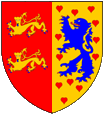
1235–1269,
coat of arms Duchy of Brunswick-Lueneburg
Source by: Wikipedia (D)

1269–1291,
Wappen Fürstentum Braunschweig,
Source by: Wikipedia (D)

1269–1705,
Wappen Fürstentum Lüneburg,
Source by Heraldique Europeenne

18th cent.,
middle coat of arms,
Principality of Brunswick-Wolfenbuettel

1667–1735,
middle coat of arms
Principality of Brunswick-Bevern,
Source: hier klicken/click here

1692–1810,
middle coat of arms,
Electorate of Brunswick-Lueneburg,
from 1814, Kingdom of Hanover,
Source by: Wikipedia (D)

1814–1918,
lesser coat of arms Duchy of Brunswick,
Source by: Wikipedia (D), Volker Preuß

1814–1918,
middle coat of arms,
Duchy of Brunswick,
Source by: Wikipedia (D)

1922–1946,
Coat of arms Free State of Brunswick,
Source: by Wikipedia (D)

The heraldry of Brunswick was determined by the ruling dynasty of the Guelphs (Welfs). The Guelfs were initially Counts in Bavaria (Count Welf, in the early 9th century), later Kings of Upper Burgundy (10th century), Duke of Carinthia and Margraves of Verona (11th century), and in 1070 they became the Dukes of Bavaria. In 1120 Henry the Proud became Duke of Saxony by heritage. Henry the Lion received in 1142 Brunswick and the Duchy of Saxony as a fiefdom, and in 1154 he also became Duke of Bavaria. In conflict with the Staufen Emperor in 1180 is imposed the imperial ban on Henry. In the following battles Henry subjects and loses large parts of his possessions. The Duchy of Saxony became divided. The west came as Duchy of Westphalia to the Archbishopric of Cologne, the east as Duchy of Saxony to the House of Ascanians. Henry the Lion keeps the central part as the Duchy of Brunswick-Lueneburg. After inheritances arised in 1296 from the Duchy of Saxony of the Ascanians the Duchies of Saxony-Lauenburg and Saxony-Wittenberg. In the year 1356 (Golden Bull) Saxony-Wittenberg was levied to the Electorate of Saxony. After the Saxon Ascanians had extincted in 1422, the Duchy and the Electorate became in 1423 handed over to the House of Wettin, the Margraves of Meissen, and it emerged the today's Saxony (Upper Saxony).
An important symbol of the (Lower-) Saxons and the Guelph Dynasty is the "Saxons Ross", a white horse on a red background. It was from time immemorial known as the crest of Duke Widukind, who defended the Saxons against the Franks in the 8th century. In the fight against the Franks the "Saxons Ross" quickly became the legendary symbol of all Saxons. This symbol became adoped by the Guelphs in their heraldry in the year 1361. In this way became it the heraldic animal of the Kingdom of Hanover (since 1866 Prussian Province of Hannover), of the Prussian Province of Westfalia and since 1922 of the Country of Brunswick. This tradition is continued in the FRG at those federal countries to which formerly Welfian territories belong. In this way they have until today the white horse in their coats of arms: Lower Saxony and North-Rhine Westfalia. In old reproductions of coats of arms (at least until 1945) the Saxons Ross held its tail always upward. With the new-creation of the State of Hannover was that tradition broken after the Second World War, because the Saxons Ross held on its flag its tail downwards. That was continued in the Country of Lower Saxony – the successor of the State of Hannover. Because of that the Saxons Ross is called in Westfalia (wehre it holds the tail still upward) "Westfalia Horse", in contrast to the "Lower Saxony Horse".
The Guelph Henry the Lion, actually Heinrich XII., married in 1168 Matilda, daughter of the King of England, from the House of Anjou-Plantagenet. In 1184 was born, as the fifth child of this marriage, William "Long Sword", the Duke of Lueneburg. He used the maternal, English coats of arms in reduced form. It showed only two golden lions (instead of three) on a red background. That symbol will take over as a sign of Guelph heraldry through all times. William "Long Sword" married in 1202 Helen, daughter of the King of Denmark. In 1204 was born, Otto I. "the Child", Duke of Brunswick-Lueneburg. He used the maternal, Danish coat of arms in reduced form: two blue lions (instead of three) in a golden field, sprinkled with red hearts. The son of Otto I., Albert I. "the Great", born in 1279, Duke of Brunswick-Luneburg, used reduced English coat of arms with two golden lions on a red background. The grandson of Albert I., Magnus I. "the Pious", born 1369, Duke of Brunswick-Lueneburg, combined in his coat of arms the two English lions with one of the Danish lions. Thus, the coat of arms of the Dukes of Brunswick had received its final form: Blazon, small (lesser) coat of arms, Duchy of Brunswick: "splited, on the right in red, zwo walking, blue-armored, leoparded golden lions with sticked out blue tongues, over each other, to the left in a with red hearts sprinkled field, one red-armored, blue lion with sticked out red tongue."
The shields of the large coats of arms are very abundant divided and show a lot of fields, that reflects herald pieces of family lines or territorial acquisitions. Sometimes within the coat of arms was shown a red central shield with the "Saxons Ross".
Source: Ronald Preuß, Volker Preuß, Deutsche Staatenkunde - Band 2,
www.niedersachsen.de


to 1815(?),
Cockade of Brunswick

to 1919,
Cockade of Brunswick
In the Napoleonic period, the cockade of the country was single coloured black, presumably until 1815, as in Hanover, also governed by the Welf dynasty. The authors know nothing more about the coloration and design of the blanket between the end of the Napoleonic era and the end of the monarchy in the year 1918.
Source: Jürgen Kaltschmitt, nach
1) O. v. Pivka/M. Roffe, "The black Brunswickers" (früher Osprey-Men-at-Arms-Band - OHNE Nummerierung), Oxford 1973
2) O. v. Pivka/B. Fosten, "Brunswick Troops 1809-1815" (Band 167 der Men-at-Arms-Reihe), Osprey, London 1985

Read here:
Informations, history and facts about the theme "Cockades".

Cockade

The splitting of the Guelphs into different lines from 1269 divides the country into several principalities, however, the duchy remained as one until 1810. Each of the princes, e.g. the Prince of Grubenhagen, was also Duke of Brunswick-Lueneburg. In the years 1814/1815 meets the Vienna Congress, to do the reorganization of Europe after the Napoleonic era. The Principality of Brunswick-Wolfenbuettel became re-installed under Duke Friedrich Wilhelm as Duchy of Brunswick, and existed until 1918. The line of the Guelphs of Brunswick-Wolfenbuettel extincted in 1884.
Other lines of the Duchy reached also territorial sovereignty from 1291: the Principalities of Calenberg, Goettingen, Grubenhagen and Lueneburg (since 1261). The Principality of Grubenhagen became inherited to Lueneburg in 1617, Calenberg and Goettingen united in 1495 to the Principality of Calenberg-Goettingen, and that principality became levied to the Electorate of Brunswick-Lueneburg in 1692. The Principality of Lueneburg in 1705 became part of the electorate. The electorate, and thus the Duchy of Brunswick-Lueneburg ended in 1810 when it was temporarily attached to the Kingdom of Westphalia. At the Vienna Congress, the electorate was restored and levied to the Kingdom of Hanover, but it ends in 1866 when it bevame incorporated as a province of the Kingdom of Prussia. The Guelph line of Brunswick-Lueneburg ascends the throne of the Duchy of Brunswick in 1913, and will reign until 1918.
Source by: Wikipedia (D),
Volker Preuß

federal Countries of the German Empire 1871 till 1920 (all names and designations in German):
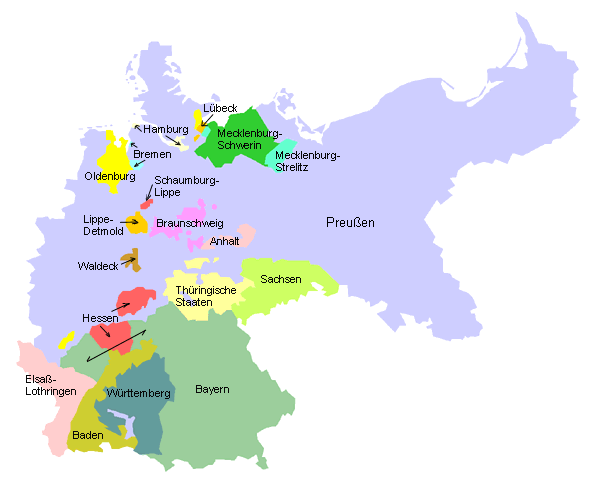
Source: Volker Preuß

Area: 1.418 square miles
Inhabitants: 495.000 (1910)
Density of Population: 349 Ew./km²
Capital: Brunswick (Braunschweig)
Currency to 1868: 1 Taler = 24 Groschen = 288 Pfennige
Currency 1868–1871: 1 Taler = 30 Silbergroschen = 300 Pfg.
Currency 1871–1924: 1 Mark = 100 Pfennig
Currency 1924–1946: 1 Reichsmark (RM) = 100 Reichspfennig (Rpf.)
Source:
Wikipedia (D),
Der Michel,
Volker Preuß

1142 · Henry the Lion of the House of Guelph (Welf) receives Brunswick and the Duchy of Saxony as a fiefdom
1154 · Henry the Lion becomes Duke of Bavaria
1180 · in the conflict with the Staufen Emperor, Henry gets outlawed, in the following struggles Henry subjects and loses all possessions (even Bavaria), except Brunswick and Lueneburg, and some very small areas, Duke of Saxony becomes the Bernhard I. of Anhalt (Ascanian Dynasty)
1235 · Otto the Child transfersall his possessions back to the Emperor, these become summarized as Duchy of Brunswick and e-transmited to Henry, as the Duke of Brunswick
1269 · The Duchy of Brunswick becomes divided into the Principality of Brunswick and the Principality of Lueneburg, however, it remains formally as Duchy of Brunswick-Lueneburg
1291 · in consequence of further divisions arise, inter alia, the Principality of Calenberg-Goettingen and the Principality of Brunswick-Wolfenbuettel, the Brunswick principalities (except Brunswick-Wolfenbuettel) become united in the following years, and form from 1692 the Electorate of Brunswick-Lueneburg (also called: Electorate of Hanover)
1792, 1796, 1800 and 1805 · invasions of French revolutionary troops under Napoléon into the German Empire, the German Empire subjects and becomes territorially transformed by Napoléon: church possessions become confiscated, old princely territories become repealed and transferred to other old or new principalities
1st of August in 1806 · the Holy Roman Empire of German Nation ends
1807 · Napoleon forms the Kingdom of Westphalia under his brother Jérôme, it were merged not only territories of Brunswick, Prussia and Hesse, from 1810 even the whole Electorate of Hanover, the Duchy of Brunswick ends
1813 · Napoléon defeats at Leipzig in October
1814–1815 · Vienna Congress, reorganization of Europe after the Napoleonic era, the Duchy of Brunswick becomes re-installed under Duke Friedrich Wilhelm of Brunswick-Wolfenbuettel, Brunswick joins the German Confederation
1830 · uprising, Duke Charles II. flees to Switzerland, the new Duke is his brother William
1834 · Customs Union with Hanover
1841 · accession to the German Customs Union
1866 · Fratricidal War of Prussia against Austria, Brunswick is on the side of Prussia that wins the war
1871 · accession to the German Empire
1884 · Death of Duke William, extinction of the line of Brunswick-Wolfenbuettel, the succession has to go to Ernst August from Hanover (actually Brunswick-Lueneburg), Duke of Cumberland, he should ascend the throne, but Hanover and his Guelph (Welf) dynasty was one of the most powerful enemies of Prussia in the Fratricidal War of 1866, while Prussia was victorious in this war – the Kingdom of Hanover became terminated by Prussia and was incorporated to Prussia as a province, but Prussia did not want see any new Hanoverian dynasty on a German throne
2nd of November 1885 · decision of the Federal Council: the throne goes to Prince Albert of Prussia, as regent
1906 · death of Prince Albert
5th of June in 1907 · decision of the Federal Council: the throne goes to Johann Albrecht, Duke of Mecklenburg, as regent
24th of May in 1913 · Ernst August of Hanover, son of Ernst August Duke of Cumberland, marries Princess Viktoria Luise of Prussia, reconciliation between Hanover and Prussia
27th of November in 1913 · The Duke of Cumberland waived his claim to the throne of Brunswick
28th of November in 1913 · decision of the Federal Council: the throne goes to Ernst August of Hanover from the line of Brunswick-Lueneburg (Duke of Brunswick, Duke of Brunswick and Lueneburg, Prince of Hanover)
1st of November in 1913 · move of the dukal couple to Brunswick
8th of November in 1918 · overthrow of the monarchy
10th of November in 1918 · proclamation of the Socialist Republic of Brunswick
6th of January in 1922 · proclamation of the Free State of Brunswick
1934 · the territorial structure of the states of the German Empire becomes replaced by the districts of the NSDAP, the countries become meaningless
1945 · Brunswick is part of the British and part of the Soviet occupation zone
July 1945 · the Soviet-occupied areas of Brunswick become annexed to the new created Country Province of Saxony-Anhalt
23rd of November in 1946 · the British military government initiates the unification of Brunswick (only the parts of the British occupation zone) with Hanover, Oldenburg and Schaumburg-Lippe to the Country of Lower Saxony
Source: Atlas zur Geschichte,
Wikipedia (D)

The name "Brunswick" (German: Braunschweig) consists of two parts. The first syllable of "Braun" goes back to the name "Bruno", the second syllable of "schweig" refers to the Latin word "vicus", what translated means "place". Brunswick is "Bruno's Town".
Source: Handbuch der geographischen Namen







Kindly supported by: A. Kortmann (D)
![]()

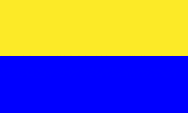





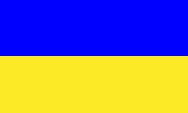


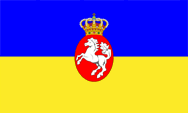


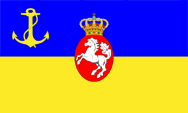


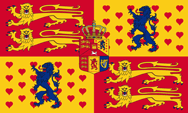















![]()